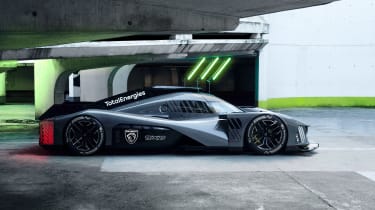‘The Hypercar class didn’t feel Hyper enough. In stark contrast, the GTE cars were awesome’
Le Mans Hypercars sound great, says Jethro. There’s just one problem…

You know that feeling after a long flight or cross-continent drive? Brain foggy, ears gently hissing like an old TV when the BBC stopped broadcasting at midnight, body feeling like parts of it aren’t quite your own? That’s me. As I write this I’m just back from Le Mans 2022 and feel completely spent. Sadly, I wasn’t driving, but the chance to work for Eurosport doing a bit of presenting and pitlane reporting seemed a great way to get close to the action. Plus, it would give me the opportunity to see the new breed of Hypercars up close and personal.
I’m sure you’ve heard about the new Hypercar class. Designed to be more relevant and to inspire a range of new road cars, much cheaper to develop and run than the stunningly complex and breathtakingly fast LMP1 cars, plus with greater flexibility in the rules to create many different solutions to the same problem. The new system also aligns the ACO (who run Le Mans) with IMSA in the US. Developing one car that can be raced across the world is key to its success. And it looks certain for success, too. Ferrari, Porsche, BMW, Peugeot and more will join Toyota and Glickenhaus by 2024. The phrase ‘golden age’ is already being bandied around.
So what makes a Le Mans Hypercar? The class is pretty loosely defined and instead of rigidly specifying engine size, dimensions of aero devices and suchlike, it instead outlines a performance window to slot into. That means you can run pure ICE or adopt hybrid systems and choose any engine configuration (including rotary – the return of Mazda is strongly rumoured). Only one set of bodywork can be homologated with just one adjustable aero device. Furthermore, you must build 25 road cars with a similar engine/MGU-K by the end of year one, rising to 100 by the end of the second season. Overall power output is restricted to 500kW (670bhp) and weight to 1030kg.
> 2023 WEC and IMSA seasons ready for launch – Le Mans Hypercar and LMDh contenders
For IMSA, the LMDh (Le Mans Daytona hybrid) class is more restrictive but potentially much cheaper. Chassis will be supplied by Dallara, Oreca, Multimatic and Ligier. A spec gearbox with integrated Bosch electric motor with just 50bhp is supplied by XTrac. As in LMH, these cars will be restricted to 670bhp and – here’s the controversial but key detail – all contenders will be subject to Balance of Performance. That means that, as in the GT3 or GTE classes, the governing bodies will adjust weight and power outputs to create a level playing field. Even fuel allocations will be adjusted. But if it means 20 cars or more lining up in the top class with a genuine shot at victory, we’ll take it. Although the thought of a Porsche prototype racer with a spec chassis and ’box and sharing an engine with a sister car from Audi seems slightly weird.
Somewhat predictably, the Toyotas scored a 1-2 at Le Mans 22 and their pace simply blew the heroic minnows of Glickenhaus away. Alpine also entered the LMH class but with a neutered LMP1 car that won’t be permitted to race next season. They finished 3rd. However, the result belies a crazy Le Mans week full of incident and intrigue, glory and heartbreak. Practice sessions were littered with crashes and spins, torrential rain blew in just before the race started, and all the time the Hypercars were squeezed and tracked by the fastest of the LMP2 class cars. The place was buzzing with the prospect of a second-tier car winning the whole damn thing.

Which is maybe the problem. The Toyotas look really cool with their F1-aping front bodywork and the Glickenhaus SCG 007 is quite beautiful. Yet… the fact that they were only j-u-s-t quick enough to outrun LMP2 cars that had been hobbled by a 20kg weight increase and a reduction in power by 67bhp meant the Hypercars didn’t have the sense of awe of the previous elite class. In fact, it almost felt like the rest of the field had been sabotaged and still the Hypercars were nervously looking over their shoulders. Is this the start of new golden age? Perhaps. But right now, without any road car equivalents to aspire to and without the overall performance to blow away existing competitors, the new Hypercar class didn’t feel Hyper enough.
In stark contrast, the GTE cars were simply awesome. The impossibly distended 911 RSR, glorious Ferrari 488s and the and savage-sounding Corvette C8.R looked better and better as they accumulated grime, insects and damage. And yet the GTE class is set to disappear with a new set of regulations in favour of a lower-spec category along the lines of GT3. As I stood a few feet behind the number 63 Corvette when its 5.5-litre flat-plane-crank V8 ripped into life, I couldn’t help but wonder if the regulations have it all wrong. Hypercars are cool. But give me a derestricted GTE car with 800bhp, a shape I can see on the roads every day but exaggerated with extreme aero, and noise that rattles organs from a mile away. That really would be a golden age.
This story was first featured in evo issue 290.



